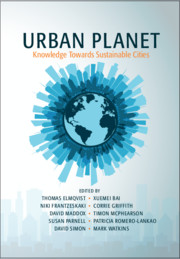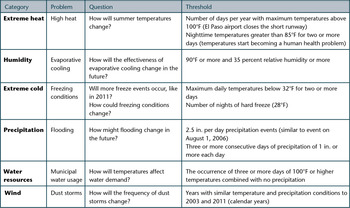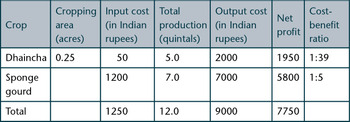12.1 Introduction
Conventional science is usually conducted in a remote location, abstracted from day-to-day conditions and needs. Even when it produces useful outputs, those outputs are rarely effectively communicated to those who could put them to best use. “Citizen science” is increasingly providing powerful alternatives to this approach.
Though citizen science often evokes images of, for example, school children measuring rainfall, we see it as a much larger field. Citizen science can range from crowd-sourcing information to participatory monitoring and action research, to collaboration between the general public and professional scientists, and to highly informed public science interests funded by citizens.
The common threads of citizen science are:
1. Citizen science functions as a check and balance on information. In places where information is controlled by governments or the private sector and there is limited access or manipulation, citizen science can increase access to information or provide alternative information.
2. Citizen science operates at different scales. It is often granular and/or collected by hundreds or thousands of people and can, therefore, provide very different information from what is available through conventional channels, allowing for investigations that have not previously been possible.
3. Citizen science is grounded locally and relates to issues that people see and/or experience on a daily basis. This relevancy aids in community ownership of the results and makes them more actionable.
4. Citizen science cultivates an informed and engaged citizenship. Participants understand the value of science and see themselves as an integral part of that science. Ideally, this translates to a more informed public and greater citizen engagement in influencing science-policy decisions.
These differences between citizen science and conventional science mean that citizen science can generate unexpected – and sometimes very different – knowledge. That knowledge can lead to transformative change in how processes are undertaken and in how people act.
Citizen science is supporting the growth of new scientific endeavors in powerful ways, particularly as technology has progressed and virtual networks have expanded, increasing scientific literacy and inclusivity (Bonney et al. Reference Bonney, Cooper, Dickinson, Kelling, Phillips, Rosenberg and Shirk2009; Connors et al. Reference Connors, Lei and Kelly2012). Yet, it is not clear that citizen science is being used to its fullest potential. Indeed, Mueller and Tippins (Reference Mueller and Tippins2012: 3) argue that citizen science has largely been top-down:
The key point is that it does not matter whether or not individuals engage in citizen science projects focused on mammals, birds, weather, climate change, flora, or invasive species. The participants primarily serve to collect data for scientists rather than to collaborate with scientists, democratize protocol and equipment, assess ideas, and work in relation to others.
For this reason, we are encouraged to see the emergence of a new type of citizen science, one based on equitable collaboration. In this citizen science, citizens are engaged as equal players in the scientific process, contributing their local, grounded perspectives, knowledges, understandings, needs, and aspirations in an ongoing and iterative process. This is related to but different from action research, which is either initiated by researchers to solve an immediate problem or is an iterative learning and doing process. Action research doesn’t necessarily engage citizens. Citizen science empowers citizens to act, and makes science directly responsive to their needs and interests. Therefore, citizen science is especially important for urban-focused science, in which a multitude of diverse perspectives and knowledges need to be captured. This chapter explores several case studies from urban areas in which citizens were engaged in equitable collaboration, and how this led to new learning and action.
12.2 Types of Citizen Science
There are two types of commonly practiced citizen science; one is focused on data collection, while the other both collects data and conducts its own analysis of that data.
12.2.1 Citizen Science as a Data Collection Mechanism
This type of citizen science involves large groups of citizens, often distributed over wide geographical areas, to collect data. This structure allows for collection of information at a geographic scale and at a level of detail that has never previously been possible. For example, in the United States, the Community Collaborative Rain, Hail and Snow Network, or CoCoRaHS, is a national project that enlists a community-based network of volunteers to measure and record precipitation data. Project staff map, analyze, and disseminate the resulting information. These results are ultimately used by a wide variety of organizations and individuals, ranging from scientists to city utilities, from emergency managers to students. CoCoRaHS’s goals are to generate and disseminate accurate precipitation data with substantially greater granularity than traditional methods have permitted, to increase community awareness about weather, to build collective awareness of climate, and to develop citizens’ skills in scientific data collection (see www.cocorahs.org).
However, this project largely perpetuates a one-way flow of data. Citizens provide data to scientists, who then undertake the analysis and dissemination. There is no direct tie back to the citizen data collectors in ways that impacts their lives. Such a structure is fairly typical of crowd-sourced data projects. Still, this form of crowd-sourcing data does combine the capacities of traditional science with the capacities of communities to collect extensive data while raising citizen awareness about science.
12.2.2 Citizen Science as a Citizen Scientific Analysis
A less common form of citizen science involves citizens in the analysis of the data they collect and, therefore, establishes a more direct interface with scientists. Citizen science of this form frequently arises either due to a lack of information and data that citizens want to address, or over questions about the validity of existing scientific knowledge. While this method allows citizens to engage more with the analysis of data and advocate for themselves and their needs, they do not have control over how the data are ultimately used in decision-making processes.
Communities in Thailand, for example, began research of this type in the early 2000s in response to the controversial Pak Mun Dam on the Mun River, the largest tributary of the Mekong River. The Pak Mun Dam was built in 1994 by the Thai government and the World Bank and had immediate adverse impacts on the environment, including fisheries, as well as the livelihoods of local residents who depended upon them. The Assembly of the Poor, a strong people’s movement, formed to protest dam operations and impacts. In response, the Thai government agreed to open the dam’s gates to restore natural flows, and to conduct studies on impacts to fisheries and communities. To ensure that people’s concerns were heard, Living River Siam, a nongovernmental organization, developed a research method for communities to conduct their own scientific studies. In what has become known as “Thai Baan” research, Pak Mun villagers systematically documented how the dam had affected their lives and the fisheries on which they depended (Herbertson Reference Herbertson2012).
Although both the conventional and citizen science studies clearly documented highly damaging impacts on ecosystems and livelihoods, the Thai government chose to continue dam operations. Dramatic declines in fisheries have continued. Nevertheless, the network of Thai communities and NGOs emerged strong and unified after the experience; the Assembly of the Poor continues to support people who were affected by development projects; and interest in Thai Baan research continues to grow. In 2004, a similar effort by villagers combining Thai Baan research and political pressure convinced the Thai government to preserve the Khon Pi Luang rapids on the Mekong River. This illustrates how citizen science can help citizens to understand the sociopolitical environment and players involved in an issue and to take action in ways that will achieve change.
12.2.3 The Limitations of These Two Models
Both citizen science as data collection mechanism and citizen science as analysis have favorable attributes for citizens and the environment and, in many cases, encourage more locally grounded actions. However, they are also top-down – the citizens involved do not have control over how the data are used, nor are they included in associated decision-making and/or planning processes. This is problematic for a number of reasons.
First, top-down science does not necessarily produce scientific knowledge that is “usable” in the local context. Usable science is knowledge that is produced through integrated processes that meet constituent needs (Lemos and Morehouse Reference Lemos and Morehouse2005). One of the most effective and powerful ways to produce usable science is through the coproduction of knowledge. This refers to an iterative process (Dilling and Lemos Reference Dilling and Lemos2011), involving both scientists and citizens, where different values, experiences, and information – which are all partial, imperfect, and situated in their local contexts (Haraway Reference Haraway1988; Harding Reference Harding2011) – are brought together to produce a common knowledge or solution to a local problem. This situated, common knowledge accounts for the range of needs and capacities that should be considered when producing and using science (Dilling and Lemos Reference Dilling and Lemos2011).
Second, scientist-driven citizen science projects do not necessarily engage meaningful public participation. Such projects tend to focus on one frame (for example, an ecological frame) and “[draw] participants into thinking they are doing something scientific when what they are doing does not nearly capture the integrated nature of science, culture, and consequences” (Mueller and Tippins Reference Mueller and Tippins2012: 6). Citizens are unlikely to gain an understanding or see the value of science – or to function as checks and balances for traditional scientific knowledge – if they are not engaging with the myriad factors (social, cultural, political, economic, technological, physical) that influence the results of science and its associated actions.
Third, the exclusion of citizens from processes that determine how citizen science data are used can dis-incentivize citizen ownership of local solutions. Citizen ownership of initiatives is important, particularly if those initiatives are aimed at responding to local problems and/or generating local outcomes. Citizen ownership can incentivize communities to sustain action over the long term and, eventually, to institutionalize the changes needed to achieve initiative goals within their communities (Shediac-Rizkallah and Bone Reference Shediac-Rizkallah and Bone1998; Simpson et al. Reference Simpson, Wood and Daws2003;). Such ownership can create real transformation. Mueller and Tippins (Reference Mueller and Tippins2012) suggest that participation in science needs to be democratized to ensure that diverse voices are engaged in dialogue based on mutual trust and respect. The experience should also be allowed to shape participants’ futures based on their needs and based on the locally embedded scientific knowledge that they are instrumental in creating. Not only will this create a more informed public, but it will also generate a public that is critical and engaged in influencing science-policy decisions.
12.2.4 A Third Type of Citizen Science: Equitable Collaboration
A third type of citizen science based on equitable collaboration needs to emerge; in some places, it is already emerging. To produce science that is embedded in the local context, and to promote environmental and social justice, citizens need to be given more power within scientific processes. This type of citizen science requires scientific processes to be codesigned and knowledge to be coproduced by scientists and citizens (Colston et al. Reference Colston, Vadjunec and Wakeford2015). Such engagement can both contextualize and customize external scientific knowledge and learning so that it can both be translated into action that is locally owned and can inform international “expert” knowledge in ways that make that knowledge more relevant.
Standout challenges of undertaking citizen science of this type in urban, as compared to rural, environments include a greater diversity of stakeholders required to provide the needed contextualization and customization, an increase in complexity, and less social cohesion, all of which can make it difficult to identify and engage stakeholders. Capturing this complexity is critical in urban-focused science and action, and further illustrates the importance of pursuing citizen science based on equitable collaboration in urban settings.
The following urban citizen science case studies emphasize what successful projects in these areas can look like. They explore how the engagement of citizens from the outset influenced the process and outcome of the studies and produced benefits for everyone involved.
12.3 Case Study One: The Odo-Osun Natural Spring Project, Ibadan, Nigeria
Oke-Offa Babasale is an unplanned, high-density, low-income residential community in Ward 10, Ibadan North-East local government area, or IbNELGA, of Ibadan, Nigeria (Figure 12.1). A spring has been the major source of water to the community for drinking and other domestic uses year-round for over 80 years (Adewoye Reference Adewoye1995). The spring is located within a densely built community and is accessible from the nearest road only by a network of foot paths running between residential buildings. Prior to the development of the spring, the water supply situation in the community was poor. Women and children (ages 8 to 16 years old) spent hours scouting for water, and there was a high incidence of waterborne diseases, typhoid fever, and cholera (Odo-Akeu Spring Water Development Project Working Group 1996; SIP-TSU n.d.).
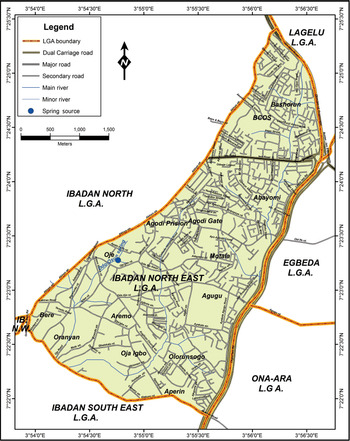
Figure 12.1 Odo-Osun Spring in Ibadan North-East local government.
The Odo-Osun Community Spring Water Development Project, or OCSWDP, was designed to provide 20 to 50 liters per person per day of clean and hygienic water to the people of Oke-Offa Babasale community and adjoining areas for an affordable fee. By improving the environment of a heavily polluted and underutilized natural spring, the project sought to enhance and sustain the community’s access to safe water.
The process of collaboration and integration evolved in stages through series of consultation and communication as follows:
The Oke-Offa Babasale Community conducted a situation analysis, identified problems related to the spring, and consulted the UN-Habitat sponsored Sustainable Ibadan Project-Technical Support Unit, also called SIP-TSU, for assistance;
SIP-TSU conducted a joint diagnostic survey of the environment and the quality of spring water with community leaders and representatives of other stakeholders;
SIP-TSU and other stakeholders communicated results using video documentation, print, and electronic media;
New water infrastructure was designed in consultation with SIP-TSU, representatives of the community, and other stakeholders;
A cost estimate was prepared and roles assigned to identified stakeholders;
Resources were mobilized, a project management committee was established, and a bank account was opened; and
Project implementation and design of a framework for operation took place between 1995 and 1997.
The SIP-TSU provided overall technical guidance and advice and assisted the community in establishing the 16-member Odo-Osun Spring Water Development Working Group, which served as the think-tank committee for the project. A respected community leader, Chief David Adewoye, coordinated the working group; it drew its membership from the community, Oyo State Department of Rural Development, Ibadan North-East LG Council, UNICEF, SIP, academia, and the private sector.
The collaboration ensured an equal partnership, based on consensus, in critical decision-making. Each side contributed time, material, financial resources, and human resources, though in varying proportions. Conventional scientists scaled up the community’s traditional method of increasing water yield from natural springs, brooks, and streams by introducing a concrete storage tank fitted with hand pumps and taps for easy and hygienic collection of water. The community members managing the project were taught how to fix simple faults in the pumps while plumbing artisans within the community could replace damaged pipes and taps.
The Odo-Osun project has resulted in a number of benefits, including increased access to hygienic water; less time spent by women and children scouting for water; improved attendance of children at school; project accountability and probity; an example of effective multi-stakeholder collaboration; capacity building for community members on water system construction and repair; improved sanitation in the vicinity of the spring; improved health and reduction in waterborne diseases among the people of the community; sustainable natural resource protection and conservation; more time for women to pursue socioeconomic activities; and a good lesson in integration of citizen science and formal science (Figure 12.2).
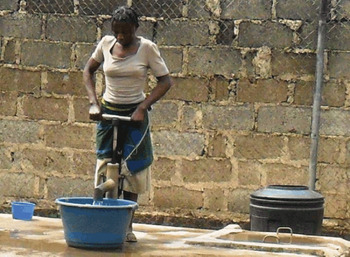
Figure 12.2 Odo-Osun spring in 2010.
However, these benefits were not achieved without effort. The project was faced with some challenges, including:
Community members initially found the pay-as-you-draw water scheme, implemented to pay for project costs and ongoing maintenance, to be alien. Many residents protested the user fees, resisted payment, and forcefully drew water.
Community members were slow to understand the sustainability-related and cost-recovery implications of self-financing the service delivery, operations, and maintenance of a community-based resource.
A fence, erected around the spring to prevent pollution and vandalization of pumps and taps, was seen as limiting the previous 24-hour access.
There were complaints against the management committee about composition of the committee, lack of information, poor communication, and overprotection of the spring.
To resolve the conflict, project participants applied indigenous approaches (Wahab and Odetokun Reference Wahab and Odetokun2014). The SIP-TSU, acting as facilitator and mediator, consulted with and mobilized representatives of Oke-Offa Babasale community, including the youth, women, and project development stakeholders, to attend a series of meetings over five months to resolve the grievances. At the end, the project put in place a more robust, inclusive project management structure composed of the representatives of each zone, the elders, youth, women, and an auditor.
The citizen-initiated OCSWDP, realized through multi-stakeholder collaboration, earned international recognition as an ambassador project on New Solutions for Sustainable Cities during the Stockholm Partnership for Sustainable Cities final event held in Stockholm, June 4–7, 2002. This project has demonstrated how citizen science can be integrated with formal science to enhance the quality of a community-based water resource, to increase a community’s access to potable water, and to promote sustainable water delivery. The project experienced some challenges from the integration of the two sciences, but these were resolved using the extant indigenous approaches to conflict resolution within the community.
12.4 Case Study Two: Using City Stakeholder-Defined Extreme Weather Thresholds to Customize Climate Projections, United States
The Climate Thresholds Project is designed to enlist city stakeholders and climate scientists to codevelop climate projection data customized specifically to city needs. Started in 2014, the project is funded by the National Oceanic and Atmospheric Administration’s Sectoral Applications Research Program and is led by Adaptation International, with support from the Southern Climate Impacts Planning Program, the Climate Assessment for the Southwest, Atmos Research, and ISET-International. The project is partnering with four cities of various sizes, capacities, and resources with a diversity of climate challenges: Boulder, Colorado; Miami, Oklahoma; Las Cruces, New Mexico; and San Angelo, Texas.
Many communities around the world are already vulnerable to extreme weather events. As climate conditions change, many of these vulnerabilities may get worse or increase in frequency, magnitude, and/or intensity. Communities already know from experience when weather goes from being a nuisance to a problem for their citizens, city operations, natural resources, and other things that matter to the community. To develop effective community responses to future change, it is essential to utilize local experience and knowledge to identify critical thresholds for extreme weather events and to understand how these events may be altered in the future as the climate changes.
To be truly useful for local decision-making, climate information needs to be as specific as possible for that community. For many communities, generic thresholds for extreme weather events are insufficient to connect people with climate impacts and catalyze actions. The Climate Thresholds Project is piloting and testing a methodology for: (1) engaging citizens to identify critical thresholds for extreme weather events specific to their communities; (2) using these thresholds to analyze localized climate projections to community-specific needs; and (3) supporting community stakeholders to take new actions in response to identified risks.
The core of the methodology is a series of community workshops in each city called Shared Learning Dialogues – participatory, multisector workshops where new information is introduced and explored collectively. This approach addresses two major challenges in building resilience and adaptive responses to climate change: 1) translating scientific information into forms useable by stakeholders; and 2) generating buy-in and developing practical solutions that include a variety of stakeholders who operate in different ways, with different tools and contexts, and from different interests (Randolph Reference 259Randolph and Goldstein2011).
Equally essential is clear information about changing climate and extreme weather conditions and the associated impacts and risks that the city will face. To date, projections of climate change have generally been provided in one of two ways: one-size-fits-all national or regional reports and datasets; or locally tailored, external, expert-driven, desktop studies. Even the best of these generally fails to present information in ways that relate to local, on-the-ground issues and needs. The Shared Learning Dialogue approach works to address this disconnection between information holders and information users by bringing them both into the dialogue and allowing both sides to learn (Tyler and Moench Reference Tyler and Moench2012). It also recognizes that information users have unique local experience that is invaluable in developing meaningful knowledge for the community.
In each city, stakeholders involved in the Shared Learning Dialogues include city and county staff; emergency management personnel; medical and mental health professionals; utility representatives; local, state, and federal researchers; and local and state decision-makers, as well as project staff and scientists. This diversity allows participants to look beyond their traditional job duties and identify areas of common interest or particular problematic climate and extreme weather events. For example, in Las Cruces, key concerns included extreme heat, extreme cold, extreme wind and dust, flooding, and city water demand, with specific questions related to each. Following the Shared Learning Dialogue, the project team worked with participants to narrow these concerns down to specific, quantifiable indicators that localized global climate models can project with medium-high confidence. Table 12.1 gives examples of participant questions and their associated thresholds.
Table 12.1 Las Cruces, NM, stakeholder-identified extreme weather thresholds
| Category | Problem | Question | Threshold |
|---|---|---|---|
| Extreme heat | High heat | How will summer temperatures change? | Number of days per year with maximum temperatures above 100°F (El Paso airport closes the short runway) |
| Nighttime temperatures greater than 85°F for two or more days (temperatures start becoming a human health problem) | |||
| Humidity | Evaporative cooling | How will the effectiveness of evaporative cooling change in the future? | 90°F or more and 35 percent relative humidity or more |
| Extreme cold | Freezing conditions | Will more freeze events occur, like in 2011? | Maximum daily temperatures below 32°F for two or more days |
| How could freezing conditions change? | Number of nights of hard freeze (28°F) | ||
| Precipitation | Flooding | How might flooding change in the future? | 2.5 in. per day precipitation events (similar to event on August 1, 2006) |
| Three or more consecutive days of precipitation of 1 in. or more each day | |||
| Water resources | Municipal water usage | How will temperatures affect water demand? | The occurrence of three or more days of 100°F or higher temperatures combined with no precipitation |
| Wind | Dust storms | How will the frequency of dust storms change? | Years with similar temperature and precipitation conditions to 2003 and 2011 (calendar years) |
Many of the thresholds identified in Las Cruces are similar to those in the other three cities – high maximum temperatures, high nighttime temperatures, increased frequency of flooding – but the exact numbers vary, fitting the local environments of each city. Other thresholds – the effectiveness of evaporative cooling and frequency of dust storms – are particular to Las Cruces.
The workshop discussions in each city have been strongly influenced by the diversity and the multisectoral views represented. Discussions have ranged from the potential climate impacts on agriculture and how they could change local culture, to explorations of the various types of climate action that will be needed and how to achieve these through local code changes, to how to educate and influence funding agencies and political entities to begin building support for acting more broadly.
The questions that city stakeholders are asking about how future climate will affect them, their operations, and the things they care about are focused and insightful. They have gone far beyond disseminating generic climate projection information. They are grappling with a broad range of possible impacts that could result from changing climatic conditions and are deciding what they can start doing today to mitigate or adapt to those impacts. These questions span departments and disciplines – the county transportation department is talking with the city sustainability officer, the police chief, and the state senator’s office staff about what their issues are and how they can work together to solve challenges. The results are dramatically more proactive than is typically achieved in a more traditional, top-down climate modeling project.
This project clearly falls into the third category of citizen science focused on equitable collaboration. The ultimate users of the information are not only those identifying thresholds, but are also those coproducing knowledge about why those thresholds are important and how to incorporate the new information they have gleaned into decision-making processes. From a scientific perspective, the results are equally expansive. Project staff are being pushed to identify resources for city players that can help them generate urban heat island maps, understand the potential impacts of climate change on crops, and explore how to distinguish between natural variability and changing climatic conditions. The questions that city stakeholders are asking make it clear how much more could be done to make climate projection information actionable and are generating exciting new avenues for scientific exploration.
12.5 Case Study Three: Adversity to Advantage in Gorakhpur, India
Climate change is threatening food production systems and, therefore, the livelihoods and food security of millions of people who depend on agriculture in India. Consistent warming trends and more frequent and intense extreme weather events have been observed in recent decades, and climate change projections show consistent temperature increases and erratic precipitation trends. Farmers must adapt to these changing conditions to build resilient livelihoods.
People involved in agriculture tend to be among the poorest urban residents, and the poorest of all tend to be women farmers. Yet the women farmers of Mahewa ward of Gorakhpur city, in eastern Uttar Pradesh, have been adopting innovative and resilient agricultural practices. These practices have sustained their farming – especially vegetable cultivation – in an area that is acutely waterlogged.
Mahewa ward is situated in a low-lying area on the southwestern periphery of Gorakhpur city (Figure 12.3) where residents have particularly poor socioeconomic status. Located near a wholesale vegetable market, the majority of the farmers of Mahewa ward grow vegetables to sustain their livelihoods. Waterlogging and weather uncertainties – such as late monsoons, intense rains, and drought – adversely impact the vegetable farming in the area. Farming in such challenging conditions has been successful only because of the synergy between scientific methods adopted by the farmers and the application of citizen science.
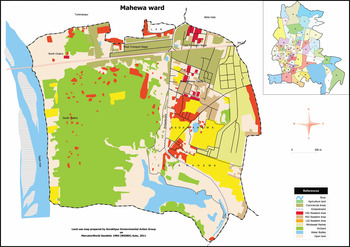
Figure 12.3 Mahewa ward, Gorakhpur, India.
Gorakhpur Environmental Action Group, or GEAG, formed under the Asian Cities Climate Change Resilience Network initiative, began promoting resilient agriculture with small, marginal, and women farmers in 2010. Their underlying strategy is to make farming economically viable and to demonstrate new, climate-resilient farming techniques.
To engage with farmers, GEAG set up and facilitated a neighborhood committee on Climate Resilient Agriculture, or CRA. The CRA committee provides a platform for farmers to share their agriculture-related problems and to find solutions. Since the platform meets monthly at the ward level, it is easy for women farmers to access, participate, and learn new methods of farming. This platform has been instrumental in scaling up new techniques to other farmers.
One of the key agricultural practices promoted by GEAG in the CRA committee has been dhaincha (Sesbania aculeate; Figure 12.4) farming. Dhaincha is a leguminous crop that is tolerant of high saline and waterlogged conditions. It is popularly and scientifically known for its green manuring attributes; scientists recommend it as a measure to reclaim alkaline soils that have been induced by waterlogging. GEAG’s past experiences had shown that dhaincha survives very well in waterlogged conditions.
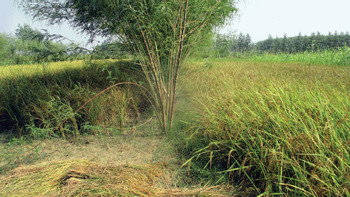
Figure 12.4 Dhaincha (center).
The farmers who grew dhaincha for a year saw additional potential uses for the crop. They began using the hard, semi-woody stem of dhaincha as the base for climber crops in a multitier cropping system. This unique method of crop combination (dhaincha with vegetable crops) helps reduce the impacts of waterlogging on the vegetable crops and, simultaneously, increases soil fertility when the farmers plough dhaincha back into the soil after the vegetable crop is harvested. Farmers also began using dhaincha as fuel and as fodder for livestock. In the CRA committee meetings, successes were shared and expanded.
Dhaincha farming has improved the incomes of local farmers. Table 12.2 shows the income of Ms. I.D., a farmer in Mahewa ward, who sowed dhaincha along with sponge gourd on a quarter of an acre of land. With an input cost of Rs. 1250 (18.75 USD), she earned profits worth Rs. 7750 (116.50 USD).
Table 12.2 Cost-benefit ratio of dhaincha cultivation
| Crop | Cropping area (acres) | Input cost (in Indian rupees) | Total production (quintals) | Output cost (in Indian rupees) | Net profit | Cost-benefit ratio |
|---|---|---|---|---|---|---|
| Dhaincha | 0.25 | 50 | 5.0 | 2000 | 1950 | 1:39 |
| Sponge gourd | 1200 | 7.0 | 7000 | 5800 | 1:5 | |
| Total | 1250 | 12.0 | 9000 | 7750 |
Dhaincha is very popular in the urban environment. The intervention started with 10 farmers; now, more than 500 farmers have adopted it. The farmers are also promoting this technique in farmer field schools, meetings, in farmers’ fairs, and so forth. Word-of-mouth popularity has produced much recognition and adoption of the crop. Farmers have also started using it as a “trap crop,” as it provides protection against pests and insects.
Equitable collaboration between GEAG and the farmers improved the dhaincha farming model substantially. The resulting model delivers sustainable social and economic benefits to poor farmers, enabling them to increase their incomes and improve the quality of their lives. Such local innovations are attracting large numbers of other farmers who are facing similar problems farming in waterlogged contexts and are experiencing deteriorating soil health. Today, this citizen science initiative, acting in synergy with conventional science, is helping approximately 800 farmers in this flood-affected region.
12.6 Discussion
All three case studies fall into our third category of citizen science, which focuses on equitable collaboration. In all three cases, scientists worked with citizens to coproduce knowledge about how information could be best used locally. This process was facilitated by boundary organizations that have links to the community and experts. Likewise, in all three cases, the outside experts learned how extensively their information needed to be tailored to be adapted for local action.
These case studies illustrate several elements that we believe should be at the foundation of citizen science if it is to reach its full potential:
1. Coproduction of knowledge, as illustrated in the dhaincha farming study
2. Meaningful participation, as illustrated in the climate thresholds study
3. Citizen ownership of solutions, as illustrated in the Odo-Osun study
We note that, in addition to these three elements, monitoring and evaluation is a growing area of donor interest and an undertaking that supports the development of strong science, particularly science focused on producing change. As such, we see monitoring and evaluation as fundamental to citizen science and an area in which citizen science could grow considerably. However, a detailed exploration of monitoring and evaluation, insofar as it can help support and develop citizen science, is beyond the scope of this chapter.
The dhaincha farming case study illustrates the benefits of coproduction of knowledge. GEAG brought top-down information on green manuring with dhaincha into Mahewa ward, but it was the women farmers, working together and with GEAG, who quickly realized dhaincha could also be used to address other issues they were having – trouble growing vegetable crops in waterlogged soils and lack of fuel and fodder. By customizing the top-down information with bottom-up knowledge of local needs and capacities, highly useful science was created. The credibility, legitimacy, and saliency of this knowledge to the local community is evident in the rapid uptake and continued development of this crop by other farmers, and in the economic impacts it is having on farmers’ lives.
The climate thresholds case study illustrates the value of meaningful participation. Climate projection data have been available in the United States for well over a decade, yet governments, agencies, organizations, and businesses are only just beginning to take action to mitigate climate emissions or to adapt to anticipated climate change impacts. Action, where taken, still tends to be highly focused within one or a few sectors. In this case study, the use of Shared Learning Dialogues to convene highly diverse, multidisciplinary groups significantly changed the content of the dialogue in all four project cities. Participants’ thinking became substantially broader, opportunities for cross-sectoral collaboration were identified, and local stakeholders began actively exploring the depths of internal and external expert knowledge in the room. This is only possible when participants feel they are engaged as equals, such that their knowledge, perspective, and opinions matter.
Finally, the Odo-Osun case study illustrates the value of citizen ownership of solutions. Many of the issues identified as challenges for the Odo-Osun project are typical of development projects worldwide – conflict over who is involved, over access, and over cost. The other common cause of project failure is selection of technology that cannot be maintained by those using it. By keeping the community at the heart of this project, technologies the community could maintain were preserved, and the challenges were addressed.
All three types of citizen action explored in this chapter – citizen data collection, citizen analysis, and equitable collaboration – are valuable. Citizen data collection is changing the nature of information available to conventional science and is making new analyses possible. Similarly, citizen analysis is challenging the conventional knowledge base and provides much broader sets of data and assessments in the conducted areas. Nonetheless, we believe the real power of citizen science lies in the third area – equitable collaboration. The three case studies we have explored here demonstrate the different cultures, problems, and solutions that are present in urban settings; still, the core method of equitable collaboration used in all three cases has contributed to the success of all three projects, has led to learning both for the citizens and scientists involved, and, through co-development of project focuses and goals, has produced valuable outcomes for the citizens who participated in the work.
12.7 Opportunities Moving Forward
Citizen science is changing the scientific process in powerful ways, and its full potential has yet to be tapped. However, to add value, citizen science needs to be done well, which takes time and funding. If we are to invest our time and money, where should we focus to make our investment as influential as possible?
Some of the opportunities we see include:
Scale: Citizen science can help bridge the micro- versus macroscale gap. Conventional knowledge, particularly outside the developed world, is generally only available at a macroscale, and, frequently, it is stuck there due to a lack of finer-scale data. Increasingly, citizen science can help us to close that gap, informing the macroscale picture with microscale detail.
Framing: Many of the data that can be easily captured by citizens aren’t data that scientists can use. We need to explore ways to take what can be captured easily and to give it value.
Techniques: Local knowledge, such as changes in distribution of indicator species, is not easily crowd-sourced. We need more research into what communities know and how this could support, or challenge, conventional science; how citizens can capture this information and feed it into conventional science; and how we can incentivize citizen participation.
Validation: Science typically requires verifiable information rather than perception, myth, or ideology. Yet, citizen-collected data are often based on perception, and in the context of vastly differing lived experiences for citizen scientists and conventional scientists. These perceptions are an important part of how fact is interpreted and provide valuable information about existing needs, values, and constraints. While perceptions are difficult to validate, collaborative engagement between citizens and conventional science can help bridge the gap between formal and informal ways of knowing and create a knowledge that is valid and relevant for a given context.
Ownership and action: Increased coproduction of science can lead to high feelings of ownership and high levels of action based on the research results. Refining techniques for building ownership and fostering action will assist in scaling coproduction up and out.
Overall, citizen science is supporting the growth of new science endeavors in exciting ways, particularly as technology has progressed and virtual networks have expanded, increasing scientific literacy and inclusivity of contributors. But, it is not being utilized to its full potential. In this chapter, we have identified the value and opportunities for conducting citizen science that is more equitable and collaborative as a means of narrowing the gap between knowledge and action, particularly in urban settings. We know there are multiple organizations that have been practicing this type of science for years, as illustrated by the studies explored here. We hope this chapter inspires more organizations to embrace citizen science, both for the benefit of citizens, for the benefit of research, and for the benefit of the positive change it can affect for us all.



